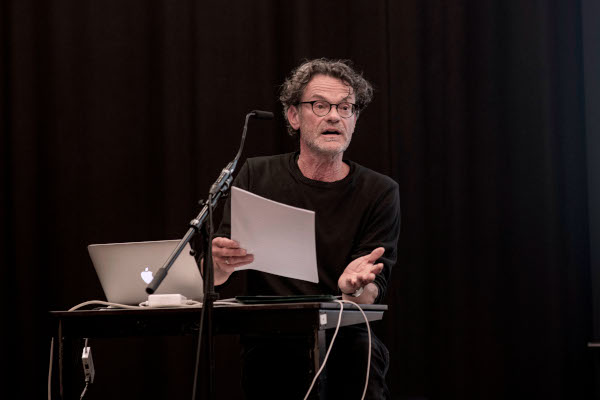
I discovered Timo Hoyer and his book on composer Anthony Braxton ‘Anthony Braxton. Creative Music’ browsing the catalog of the German publisher wolke verlag, of which I had reviewed the volume of Marcus Müller ‘Free Music Production FMP: The Living Music’ (here). The size of the volume and the topic dealt with have intrigued me to the point of contacting, with the help of the publishing house, Timo Hoyer to tell me the story of this powerful work. The book is in German, but I hope it will be translated into English as soon as possible. In the meantime I invite you to read the interview.
Here you can find the Italian Translation
When did you become so passionate about the music of Anthony Braxton?
That was in 1989. Braxton was playing in a trio with Swiss bassist Adelhard Roidinger and British free improv drummer Tony Oxley. At that time I was listening mostly to blues, blues rock, Tom Waits and stuff like that. But I also slowly started to catch fire for avant-garde jazz, Coltrane, Coleman, the electric Miles Davis. The trio’s concert was a shock as well as a revelation for me. Everything about this incredibly intense, open and at the same time mysteriously organized music affected me deeply. From then on, it was clear to me that I wanted to hear more and more from this musician. I had no idea, of course, what it meant to keep up with Braxton‘s extraordinary productivity.
When did you feel it was the right time to write a book about him?
I’ve published about Braxton on and off over the years; concert and record reviews, articles, an interview. The idea of writing a book came up in 2018. There are some fantastic studies about Braxton by Graham Lock, Ronald Radano, Peter Niklas Wilson and Stuart Broomer. But in them you learn little or nothing about Braxton‘s musical development over the last three decades. So my original plan was to write a small, approximately 160-page study of his more recent musical models. But in preparing for it, I realized that there is so much more to tell about this amazing man, his music, his holistic system, and his aesthetic thinking. In the end, it turned out to be over 700 pages. And it could easily have been twice as many.

What research did you do? Which texts did you refer to when writing your book?
The most important thing, of course, was to listen to his music. We are talking about several hundred albums and about 700 compositions! In addition, there are hundreds of non-published concert recordings to which I had access. Also indispensable are his own writings: his “Tri-Axium Writings”, his “Research Papers”, his “Composition Notes” and his (as yet unpublished) “System Notes”. Important sources are also his numerous interviews and the already existing studies. And not to forget, if I had open questions, I could ask the master directly.
How is the book structured? What are the central contents?
The book has two parts that complement each other, but do not necessarily build stringently on each other. In the first part – “Creative Life” – I proceed mainly biographically. I describe Braxton‘s childhood in Black Metropolis, his complex family history, his career as a musician, his professorships, his promotion of young musicans, the establishment of his Tri-Centric Foundation, etc. In the second part – “Creative Musics” – I focus on his aesthetic considerations and extensive on his musical concepts. Starting with his solo music (Language Music), his duo, quartet and orchestral music, his open improvisations, his standard interpretations and finally his more recent models (Ghost Trance Music, Falling River Music etc.) up to his gigantic opera project (Trillium). In the appendix of the book I discuss briefly the performer, his immense discography and his great impact on other musicians.
I must say I am especially glad with the numerous photos from all of Braxton‘s creative periods and his beautiful scores that I was able to print.

What do you think are the key concepts of the musical philosophy of Anthony Braxton?
I would say Braxton‘s most fundamental principle is: be creative. Since his formative years in the Association for the Advancement of Creative Musicians (AACM), the magic word creativity represents just about everything in which he finds fulfillment, what he believes in and what he hopes to achieve. In his view, creativity is not a sideline that can be done or left undone. Rather, it is a necessary act of human self-expression, self-realization, and self-shaping that cannot be replaced by anything else.
Closely related to his affirmation of creativity is his affirmation of transformation and variety. Braxton‘s need for positive change and diversity is reflected in every aspect of his work: for instance in his frequently changing ensembles and collaborations, in the change of presentation forms (solo, duo, small ensembles, large ensembles, multi-orchestra, opera), in the range of musical concepts, in his openness to composed and improvised approaches beyond any idioms or categories, and, as a performer, in his use of many instruments (saxophones, clarinets, flute, piano, and others).
But as much as Braxton strives for diversity, he just as hard tries to link and synthesize different and disparate elements together. His catchy slogan is: unify, not separate.
What do you reckon are the defining creative moments in Anthony Braxton’s career so far?
Fundamental to his musical development were certainly his years in the AACM. Together with Muhal Richard Abrams, Roscoe Mitchell, Joseph Jarman, Henry Threadgill, Leo Smith, Leroy Jenkins and many others, Braxton belonged to the first generation of this immensely significant cooperation on Chicago’s South Side. He was surrounded here by free-thinking, experimental musicians who, like himself, were open to all kinds of musical and artistic proposals. This was exactly the right milieu in which Braxton was able to develop his ideas and musical projects, which were unconventional and innovative from the beginning.
He has remained true to the spirit of the AACM to this day, even though contacts with the active members have long since loosened.
Which would you recommend as a first listenings: songs, albums, boxes to start entering the world of Anthony Braxton?
This is difficult to answer. It depends heavily on one’s preferences. For example, those who are enthusiastic about Braxton‘s outstanding solo saxophone recordings – “For Alto”, “Alto Saxophone Improvisations 1979”, “Wesleyan (12 Alto Solos) 1992”, “Solo (Victoriaville) 2017”, to name just a few – may put aside the boxsets of his incomparable operas (“Trillium E”, “Trillium J”, “Trillium R”). And vice versa.
Anyway, I’ll make a few suggestions. What worked for me may work for others, so as a start I recommend a CD with Braxton, Roidinger and Oxley: “Seven Compositions (Trio) 1989”. Next I would reach for an album with his mind-blowing Ghost Trance Music: eg. “Septet (Pittsburgh) 2008”. Then maybe one of his idiosyncratic tribute albums: for example, seven CD’s with Braxton on piano, dedicated to Lennie Tristano and his circle: “Quintet (Tristano) 2014”. Braxton is also a master of open improvisation, very refreshing are the recordings with Taylor Ho Bynum, Nels Cline and Greg Saunier: “Quartet (New Haven) 2014”. Definitely worth listening is his orchestral music, the classic “Creative Orchestra Music 1976” is not a bit dated.
And now I haven’t even mentioned a single duo record and nothing of his electro-acoustic Diamond Curtain Wall Music, his Echo Echo Mirror House Music, his Zim Music and so on. So the best will be, everyone browse a bit on bandcamp: https://newbraxtonhouse.bandcamp.com
Which artists, in your opinion, have been and are currently influenced by Braxton?
That makes for a very long list. The biggest impact has probably been made by his groundbreaking solo recordings with the alto saxophone. Braxton opened doors as a soloist through which an infinite number of improvisational musicians (not just saxophonists) have passed since.
Exemplary was and is also his infinitely creative blending of composition and improvisation, with which he exploded the narrow jazz concept. He paved the way for musicians like John Zorn, Anthony Davis, Vijay Iyer, Ken Vandermark, Tyshawn Sorey and countless others.
Not to mention his direct support of young talent. As a bandleader and as a professor at Mills Collage and Wesleyan University, he has always made an effort to help young people: George Lewis, Marilyn Crispell, Mark Dresser, Ray Anderson, Mary Halvorson, Steve Lehman, Taylor Ho Bynum and many others owe important career steps to him. At the same time, Braxton also benefits from these young musicians, without whose contribution his music would be unthinkable.
As a scholar of the musician’s work: what do you think of the Tri-Centric Foundation?
Braxton‘s non-profit organization has taken two tries and gone through several transformations. Initially, the concept was somewhat similar to AACM. The TCF was a loose association of artists dedicated to promoting Braxton’s music and, as far as finances allowed, creative musicians from his circle. Today, however, the TCF is almost exclusively concerned with the dissemination and archiving of Braxton‘s work.
The now 77-year-old has learned in the six decades of his career, that creative music as he practices it would perish if one relied on grants, generosity or economic support. That is why he took matters into his own hands. With TCF comes the hope that Braxton‘s incredibly rich body of work will remain accessible to future generations.
Link: Timo Hoyer ‘Anthony Braxton. Creative Music’ on wolke verlag books on music
